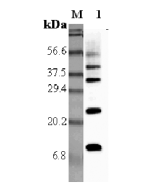Cookie Policy: This site uses cookies to improve your experience. You can find out more about our use of cookies in our Privacy Policy. By continuing to browse this site you agree to our use of cookies.
AdipoGen Life Sciences
Isotretinoin
As low as
30
CHF
CHF 30.00
In stock
Only %1 left
AG-CR1-3709-M05050 mgCHF 30.00
AG-CR1-3709-M250250 mgCHF 90.00

| Product Details | |
|---|---|
| Synonyms | AGN 190013; 13(Z)-Retinoic acid; 13-cis-Vitamin A acid |
| Product Type | Chemical |
| Properties | |
| Formula |
C20H28O2 |
| MW | 300.4 |
| CAS | 4759-48-2 |
| RTECS | VH6440000 |
| Purity Chemicals | ≥98% |
| Appearance | White powder. |
| Solubility | Soluble in DMSO (20mg/ml) or DMF (10mg/ml). Insoluble in water. |
| InChi Key | SHGAZHPCJJPHSC-XFYACQKRSA-N |
| Smiles | CC1=C(/C=C/C(C)=C/C=C/C(C)=C\C(O)=O)C(C)(C)CCC1 |
| Shipping and Handling | |
| Shipping | AMBIENT |
| Short Term Storage | +4°C |
| Long Term Storage | -20°C |
| Handling Advice |
Keep cool and dry. Protect from light and moisture. |
| Use/Stability | Stable for at least 2 years after receipt when stored at -20°C. |
| Documents | |
| MSDS |
 Download PDF Download PDF |
| Product Specification Sheet | |
| Datasheet |
 Download PDF Download PDF |
Description
- Vitamin A analog that inhibits cell proliferation and induces cell differentiation. It is converted in vivo into all-trans retinoic acid and has diverse biological activities.
- Anti-inflammatory agent used for severe acne treatment. Inhibits proliferation of primary human sebocytes by inducing cell-cycle arrest and inhibiting DNA synthesis. Amplifies production of neutrophil gelatinase-associated lipocalin (NGAL) in the skin, which has been shown to reduce sebum production by inducing apoptosis in sebaceous gland cells, while exhibiting an antimicrobial effect on Propionibacterium acnes. Decreases the size and sebum output of the sebaceous glands. It also decreases triglyceride, stearyl ester and free fatty acid synthesis and modulates keratin expression in primary human sebocyte.
- Isotretinoin produces significant anti-inflammatory effects by inhibition of monocyte and neutrophil chemotaxis across intact biological barriers in vivo.
- Shown to have anti-tumor activity, mediated through RAR-β and RAR-α receptors (low affinity). Induces mitochondrial membrane permeability transition, observed as swelling and as a decrease in membrane potential and stimulates the release of cytochrome c implicating mechanisms through the apoptosis pathway.
- Induces apoptosis in various cells. Cell death may be induced in the meibomian glands, hypothalamic cells, hippocampus cells and in sebaceous gland cells (important for acne treatment).
- Downregulated telomerase and hTERT, inhibiting cellular immortalization and tumorigenesis.
- Inhibits the action of the metalloprotease MMP-9 (gelatinase) in sebum without any influence in the action of TIMP1 and TIMP2 (the tissue inhibitors of metalloproteases).
- Promotes neurite outgrowth, cell differentiation and inhibits proliferation in a neuroblastoma cell line. Shown to have neurological effects, by binding to dopaminergic receptors in the central nervous system that may affect dopaminergic neurotransmission by disrupting the structure of dopamine receptors and decreasing dopaminergic activity. Also affects the serotonergic system by increasing expression of 5-HT1A receptors in the pre-synaptic neuron, which inhibit serotonin secretion. Additional effects on CNS involve the modulation of the retinoic acid function in the hypothalamus, the hormone regulatory centre of the brain and part of the hypothalamus-pituitary-adrenal axis, a key part of the body's stress response.
- Inducer of resistin-like molecule α (RELM-α) expression in epidermis, regulating skin immunity. The function of RELM-α is to kill bacteria of the skin via membrane disruption.
Product References
- Isotretinoin produces significant inhibition of monocyte and neutrophil chemotaxis in vivo in patients with cystic acne: D.A. Norris, et al.; J. Invest. Dermatol. 89, 38 (1987)
- Hydroperoxide-dependent cooxidation of 13-cis-retinoic acid by prostaglandin H synthase: V.M. Samokyszyn & L.J. Marnett; J. Biol. Chem. 262, 14119 (1987)
- Effects of 13-cis-retinoic acid on the hamster meibomian gland: R.W. Lambert & R.E.Smith; J. Invest. Dermatol. 92, 321 (1989)
- Effects of 13-cis-retinoic acid, all-trans-retinoic acid, and acitretin on the proliferation, lipid synthesis and keratin expression of cultured human sebocytes in vitro: C.C. Zouboulis, et al.; J. Invest. Dermatol. 96, 792 (1991)
- All-trans, 13-cis and 9-cis retinoic acids induce a fully reversible growth inhibition in HNSCC cell lines: Implications for in vivo retinoic acid use: F. Giannini, et al.; Int. J. Cancer. 70, 194 (1997)
- Cellular metabolism and actions of 13-cis-retinoic acid: W.S. Blaner, et al.; J. Am. Acad. Dermatol. 45, 129 (2001)
- Retinoids down-regulate telomerase and telomere length in a pathway distinct from leukemia cell differentiation: F. Pendino, et al.; PNAS 98, 6662 (2001)
- 13-cis retinoic acid inhibits development and progression of chronic allograft nephropathy: J. Adams, et al.; Am. J. Pathol. 167, 285 (2005)
- 13-cis Retinoic acid induces apoptosis and cell cycle arrest in human SEB-1 sebocytes: A.M. Nelson, et al.; J. Invest. Dermatol. 126, 2178 (2006)
- Neutrophil gelatinase-associated lipocalin mediates 13-cis retinoic acid-induced apoptosis of human sebaceous gland cells: A.M. Nelson, et al.; J. Clin. Invest. 118, 1468 (2008)
- Isotretinoin and psychopathology: a review: V.P. Kontaxakis, et al.; Ann. Gen. Psychiatry 8, 2 (2009)
- 13-Cis-retinoic acid decreases hypothalamic cell number in vitro: J.N. Griffin, et al.; Neurosci. Res. 68, 185 (2010)
- TRAIL contributes to the apoptotic effect of 13-cis retinoic acid in human sebaceous gland cells: A.M. Nelson, et al.; Br. J. Dermatol. 165, 526 (2011)
- Resistin-like Molecule α Provides Vitamin-A-Dependent Antimicrobial Protection in the Skin: T.A. Harris, et al.; Cell Host Microbe (Epub ahead of print) (2019)









